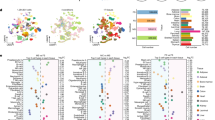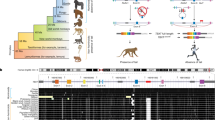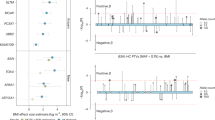Abstract
The timely secretion of gonadal sex steroids is essential for the initiation of puberty, the postpubertal maintenance of secondary sexual characteristics and the normal perinatal development of male external genitalia. Normal gonadal steroid production requires the actions of the pituitary-derived gonadotropins, luteinizing hormone and follicle-stimulating hormone. We report four human pedigrees with severe congenital gonadotropin deficiency and pubertal failure in which all affected individuals are homozygous for loss-of-function mutations in TAC3 (encoding Neurokinin B) or its receptor TACR3 (encoding NK3R). Neurokinin B, a member of the substance P–related tachykinin family, is known to be highly expressed in hypothalamic neurons that also express kisspeptin1, a recently identified regulator of gonadotropin-releasing hormone secretion2. These findings implicate Neurokinin B as a critical central regulator of human gonadal function and suggest new approaches to the pharmacological control of human reproduction and sex hormone-related diseases.
This is a preview of subscription content, access via your institution
Access options
Subscribe to this journal
Receive 12 print issues and online access
$209.00 per year
only $17.42 per issue
Buy this article
- Purchase on Springer Link
- Instant access to full article PDF
Prices may be subject to local taxes which are calculated during checkout




Similar content being viewed by others
Accession codes
References
Goodman, R.L. et al. Kisspeptin neurons in the arcuate nucleus of the ewe express both dynorphin A and neurokinin B. Endocrinology 148, 5752–5760 (2007).
Gianetti, E. & Seminara, S. Kisspeptin and KISS1R: a critical pathway in the reproductive system. Reproduction 136, 295–301 (2008).
Plant, T.M. Hypothalamic control of the pituitary-gonadal axis in higher primates: key advances over the last two decades. J. Neuroendocrinol. 20, 719–726 (2008).
Herbison, A.E. Physiology of the GnRH neuronal network. in Knobil and Neill's Physiology of Reproduction (ed. Neill, J.D.) 1415–1482 (Elsevier, Amsterdam, 2006).
Herbison, A.E. Genetics of puberty. Horm. Res. 68 (suppl. 5), 75–79 (2007).
Seminara, S.B. et al. The GPR54 gene as a regulator of puberty. N. Engl. J. Med. 349, 1614–1627 (2003).
de Roux, N. et al. Hypogonadotropic hypogonadism due to loss of function of the KiSS1-derived peptide receptor GPR54. Proc. Natl. Acad. Sci. USA 100, 10972–10976 (2003).
Crowley, W.F., Pitteloud, N. & Seminara, S. New genes controlling human reproduction and how you find them. Trans. Am. Clin. Climatol. Assoc. 119, 29–38 (2008).
Carr, I.M., Flintoff, K., Taylor, G.R., Markham, A.F. & Bonthron, D.T. Interactive visual analysis of SNP data for rapid autozygosity mapping in consanguineous families. Hum. Mutat. 27, 1041–1046 (2006).
Sandoval-Guzman, T. & Rance, N.E. Central injection of senktide, an NK3 receptor agonist, or neuropeptide Y inhibits LH secretion and induces different patterns of Fos expression in the rat hypothalamus. Brain Res. 1026, 307–312 (2004).
Rance, N.E. Menopause and the human hypothalamus: evidence for the role of kisspeptin/neurokinin B neurons in the regulation of estrogen negative feedback. Peptides published online, doi:10.1016/j.peptides.2008.05.016 (28 May 2008).
Almeida, T.A. et al. Tachykinins and tachykinin receptors: structure and activity relationships. Curr. Med. Chem. 11, 2045–2081 (2004).
Patacchini, R., Quartara, L., Rovero, P., Goso, C. & Maggi, C.A. Role of C-terminal amidation on the biological activity of neurokinin A derivatives with agonist and antagonist properties. J. Pharmacol. Exp. Ther. 264, 17–21 (1993).
Grumbach, M.M. A window of opportunity: the diagnosis of gonadotropin deficiency in the male infant. J. Clin. Endocrinol. Metab. 90, 3122–3127 (2005).
Pinto, F.M. et al. mRNA expression of tachykinins and tachykinin receptors in different human tissues. Eur. J. Pharmacol. 494, 233–239 (2004).
Hasenohrl, R.U. et al. Substance P and its role in neural mechanisms governing learning, anxiety and functional recovery. Neuropeptides 34, 272–280 (2000).
Siuciak, J.A. et al. Disruption of the neurokinin-3 receptor (NK3) in mice leads to cognitive deficits. Psychopharmacology (Berl.) 194, 185–195 (2007).
Saito, S. et al. An association study of tachykinin receptor 3 gene with schizophrenia in the Japanese population. Neuroreport 19, 471–473 (2008).
Krajewski, S.J. et al. Morphological evidence that neurokinin B modulates gonadotropin-releasing hormone secretion via neurokinin 3 receptors in the rat median eminence. J. Comp. Neurol. 489, 372–386 (2005).
Todman, M.G., Han, S.K. & Herbison, A.E. Profiling neurotransmitter receptor expression in mouse gonadotropin-releasing hormone neurons using green fluorescent protein-promoter transgenics and microarrays. Neuroscience 132, 703–712 (2005).
Goubillon, M.L. et al. Identification of neurokinin B expressing neurons as an highly estrogen-receptive, sexually dimorphic cell group in the ovine arcuate nucleus. Endocrinology 141, 4218–4225 (2000).
Ciofi, P., Leroy, D. & Tramu, G. Sexual dimorphism in the organization of the rat hypothalamic infundibular area. Neuroscience 141, 1731–1745 (2006).
Burke, M.C., Letts, P.A., Krajewski, S.J. & Rance, N.E. Coexpression of dynorphin and neurokinin B immunoreactivity in the rat hypothalamus: morphologic evidence of interrelated function within the arcuate nucleus. J. Comp. Neurol. 498, 712–726 (2006).
Goodman, R.L. et al. Evidence that dynorphin plays a major role in mediating progesterone negative feedback on gonadotropin-releasing hormone neurons in sheep. Endocrinology 145, 2959–2967 (2004).
Patak, E., Pennefather, J.N., Fleming, A. & Story, M.E. Functional characterisation of tachykinin NK1 receptors in the mouse uterus. Br. J. Pharmacol. 137, 1247–1254 (2002).
Nordquist, R.E. et al. Cognitive performance in neurokinin 3 receptor knockout mice. Psychopharmacology (Berl.) 198, 211–220 (2008).
Kung, T.T. et al. Tachykinin NK3-receptor deficiency does not inhibit pulmonary eosinophilia in allergic mice. Pharmacol. Res. 50, 611–615 (2004).
Grynkiewicz, G., Poenie, M. & Tsien, R.Y. A new generation of Ca2+ indicators with greatly improved fluorescence properties. J. Biol. Chem. 260, 3440–3450 (1985).
Acknowledgements
This work was supported by grants to A.K.T., N.O.M. and B.Y. from the Scientific and Technological Research Council of Turkey (TÜBİTAK): The Support Programme for Scientific and Technological Research Projects (1001), project 106S276; and from the Cukurova University Scientific Research Projects Support Unit, grant TF-2006-BAP20; by the Wellcome Trust (R.K.S., Intermediate Clinical Fellowship 080952/Z/06/Z; S.O., Programme Grant 078986/Z/06/Z; F.R., Senior Basic Science Fellowship) and the UK National Institute for Health Research Cambridge Biomedical Research Centre. F.R. has also received support from St. John's College, Cambridge, UK.
Author information
Authors and Affiliations
Contributions
This study was designed by A.K.T. Identification of subjects and phenotypic assessment were undertaken by A.K.T., M.G., A.S.Y., N.O.M, M.N.O., S.I., N.S.A. and B.Y. DNA extraction, autozygosity mapping, and DNA sequencing were performed by A.K.T., L.D.K. and A.S.; mutagenesis, cloning and functional studies were undertaken by F.R., K.M.P., R.K.S. and J.R.C. The manuscript was written by A.K.T., R.K.S., F.R. and S.O.
Corresponding authors
Supplementary information
Supplementary Text and Figures
Supplementary Figure 1, Supplementary Tables 1 and 2, Supplementary Note, Supplementary Methods (PDF 401 kb)
Rights and permissions
About this article
Cite this article
Topaloglu, A., Reimann, F., Guclu, M. et al. TAC3 and TACR3 mutations in familial hypogonadotropic hypogonadism reveal a key role for Neurokinin B in the central control of reproduction. Nat Genet 41, 354–358 (2009). https://doi.org/10.1038/ng.306
Received:
Accepted:
Published:
Issue Date:
DOI: https://doi.org/10.1038/ng.306
This article is cited by
-
Insights into the genetics of menopausal vasomotor symptoms: genome-wide analyses of routinely-collected primary care health records
BMC Medical Genomics (2023)
-
Mechanisms of ovarian aging in women: a review
Journal of Ovarian Research (2023)
-
Identification of quantitative trait loci and associated candidate genes for pregnancy success in Angus–Brahman crossbred heifers
Journal of Animal Science and Biotechnology (2023)
-
Computational prognostic evaluation of Alzheimer’s drugs from FDA-approved database through structural conformational dynamics and drug repositioning approaches
Scientific Reports (2023)
-
Interplay between hippocampal TACR3 and systemic testosterone in regulating anxiety-associated synaptic plasticity
Molecular Psychiatry (2023)



